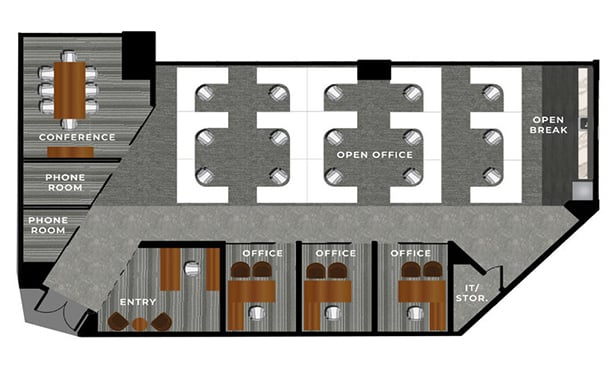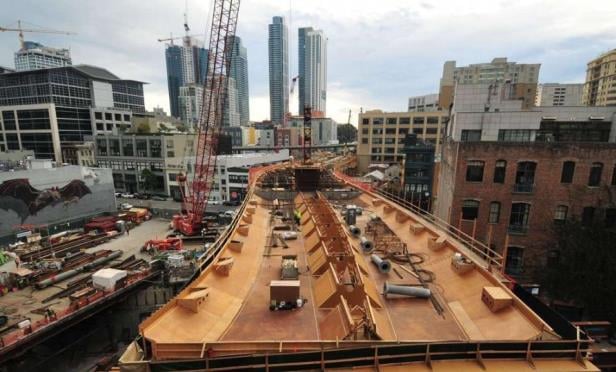LOS ANGELES—As the modular construction industry—comprised of companies that construct major components of buildings in factories that can be efficiently assembled at a build site—develops improved capabilities and continues to offer an affordable supplement to on-the-ground construction crews, more developers have reason to consider this unique construction solution. Modular components usually include entire rooms or units, and once constructed in multifamily or mixed-use development, are transported to project sites, stacked by cranes like Lego blocks and assembled by contractors on site. Choosing this method can bring dramatic savings, but there are risks associated with this type of construction that developers need to know.
We sat down with Rob Campbell, Los Angeles-based partner at Cox, Castle & Nicholson, to get an inside look at precautionary measures that developers should consider before beginning a modular construction project.
GlobeSt.com: As a construction lawyer, you are exposed to disputes that range from project delays to scope issues to damages scenarios. How does introducing the element of modular construction help or hinder a project?
Rob Campbell: Modular construction is an attractive project delivery option in that it may be a less expensive and quicker way to build. It is generally less expensive to construct modular components in a factory setting than on site and, in the case of medium-rise structures, up in the open air. In most cases, the modules come with roughed-in and partially finished plumbing, mechanical and electrical systems. When modules are delivered to the site, they are ready for assembly.
Module manufacturers, in my experience, do not perform onsite construction activities. They ship the modules to the site and coordinate crane activities which the owner contracts for.
Under the traditional project delivery model, the owner contracts separately for the design and construction. The general contractor subcontracts with various trades. Typical AIA and other forms of agreements contain flow-down clauses that bind “subcontractors” to the general contractor under the same terms as the general contractor is bound and held accountable to the owner. The obligations flow down, and these clauses are very helpful in protecting a project's stakeholders.
However, a module manufacturer may not be considered a “subcontractor” under the prime contract and thus not subject to the flow-down clause. Instead, it may be considered a “manufacturer.” In this scenario, the owner cannot assume that the flow-down clause will incorporate the prime contract terms and conditions into the manufacturing agreement because it will not be treated as a “subcontract.”
Owners must treat their modular manufacturer differently. If, for example, a typical AIA form of agreement or the standard AGC form of agreement is used, it will not contemplate the use of a manufacturer; it only will contemplate the use of subs. Owners need to modify the project's agreements to account for the differences that arise when dealing with a manufacturer that is supplying the guts of a project.
Otherwise, the manufacturer will evade standard prime contract requirements which typically flow down to the subs. The fiction that a modular manufacturer should be treated as a mere product supplier creates the need for additional risk management. Provisions dealing with retention, insurance, indemnity, bonds, warranties, lien releases and other subjects need to be separately negotiated for purposes of a modular manufacturer.
Interestingly, in the factory of a modular construction company, there are framers, painters, plumbers, electricians, etc. If these individuals were doing the same work on a project site they would need to be licensed contractors, but state law currently does not clearly require that this same work, performed in a factory, to require licensed trades. This is an area where the law has not caught up to what is happening in the marketplace.
It is important that developers that are trying this kind of project for the first time take precautionary steps so that they can protect themselves when complications arise or delivery dates are missed.
GlobeSt.com: What complications can arise with modular construction?
Campbell: I am familiar with an instance where a project owner—a several-story apartment building developer—contracted with a general contractor that contracted with a module manufacturer. At the beginning of the project, the manufacturer defaulted on its agreement with the general contractor and refused to perform.
In the case of the apartment project, the modular construction company gave away the owner's timeslot on the assembly line which created a huge monetary loss for the project, and forced the owner to find an alternative modular manufacturer to fill the void—a process which is far more involved than replacing a specific subcontractor that works onsite. The owner lost millions of dollars in increased manufacturing costs and delays as a consequence of having to replace the manufacturer.
Most subcontractors can be fairly easily replaced. The same is not true of modular manufacturers. They are not fungible. Even though modular construction has been around for a while, there are only a limited amount of vendors, and these vendors have assembly line reservations of their own to fulfill.
The modular manufacturer for this project took the position that it was just a manufacturer and not a contractor of any kind. As a consequence, it did not have to be licensed, and thus did not have the same kind of requirements and responsibilities to the general contractor that it would have had under a subcontractor's flow-down clause.
Of course, the owner did not contemplate all of the issues which would arise when the manufacturer defaulted.
The prime contract provided that “subcontractors” would provide performance bonds. A performance bond guarantees that a surety's principal will complete all the terms and conditions in their contract. However, the manufacturer claimed that because it was not a “subcontractor” the prime contract was not part of its agreement and it was not obligated by the prime contract to furnish a bond.
Nevertheless, modular construction companies can be obliged to provide performance bonds, and it is imperative that owners and general contractors obtain performance bonds from modular manufacturers.
GlobeSt.com: At a high level, how can an owner mitigate its risks when entering into projects with modular construction components?
Campbell: In general, the owner must approve the contract terms with the manufacturer and be involved in the negotiations with the module manufacturer, even if the manufacturer contracts under the general contractor. Alternatively, the owner may prefer to contract directly with the manufacturer.
An owner must get a performance bond from a modular construction company that spells out flow-down accountability. For owners that do not have a direct contractual relationship with the manufacturer, a performance bond will typically only run in favor of the general contractor. To fix this problem, owners should make themselves an intended third-party beneficiary of the agreement between the manufacturer and general contractor. This way, if a manufacturer under-performs—or worse, quits on a job—an owner should be able to recover under the bond.
Similarly, it is not unusual for the module manufacturer to take less than completed plans and contract with design professionals to complete the construction documents for purposes of construction in a factory. The problem with this arrangement, again, is that the owner no longer has any contractual relationship with the design professionals which may cut off the owner's right to sue the designers for bad plans. In the event of damages due to design errors and omissions, the owner may want to have direct recourse against the design team which stamped the drawings.
An owner may be fine with not having recourse against the design professionals because the manufacturer becomes a design-builder effectively. However, if an owner wants to retain a right of action against the design team, one way to fix this problem is to make sure that the manufacturer includes a provision in its design agreements that the owner is an intended beneficiary of the design services contracts and that the design professionals maintain minimum levels of professional liability insurance.
Continue Reading for Free
Register and gain access to:
- Breaking commercial real estate news and analysis, on-site and via our newsletters and custom alerts
- Educational webcasts, white papers, and ebooks from industry thought leaders
- Critical coverage of the property casualty insurance and financial advisory markets on our other ALM sites, PropertyCasualty360 and ThinkAdvisor
Already have an account? Sign In Now
© 2024 ALM Global, LLC, All Rights Reserved. Request academic re-use from www.copyright.com. All other uses, submit a request to [email protected]. For more information visit Asset & Logo Licensing.








